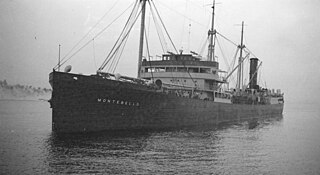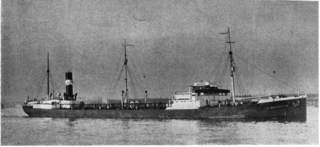
Hammac was a steam tank ship built in 1920–1921 by Bethlehem Shipbuilding Corporation of Alameda for the United States Shipping Board as part of the wartime shipbuilding program of the Emergency Fleet Corporation (EFC) to restore the nation's Merchant Marine. Early in 1923 the vessel together with two other tankers was sold to General Petroleum Corporation and renamed Emidio. The tanker spent the vast majority of her career carrying oil along the West Coast of the United States as well as between West and East coast. In December 1941 she was shelled and damaged by the Japanese submarine I-17 and eventually wrecked with a loss of five crew.
Silvanus was a steam tanker built in 1920–1921 by the Southwestern Shipbuilding & Drydock Company of San Pedro for the Anglo-Saxon Petroleum Company with the intention of transporting oil and petroleum products between Dutch East Indies and various destinations in Europe and the Far East. The tanker was employed in this capacity through the first part of 1926. In April 1926 Silvanus collided with the tanker Thomas H. Wheeler in the Mississippi River, resulting in the explosion and death of 26 seamen. Silvanus was declared a total loss and sold at auction to the newly formed Petroleum Navigation Company of Texas. The tanker was rebuilt and renamed Papoose and started operating in March 1927. In March 1942, she was attacked by German U-boat U-124 off the coast of North Carolina. The ship drifted for several days and eventually sank in 200 feet (61 m) of water off Oregon Inlet.

W. L. Steed was a steam tanker built in 1917–1918 by Bethlehem Shipbuilding Corporation of Quincy for Pan American Petroleum and Transport Company, with intention of transporting oil and petroleum products between Mexican and Gulf ports and the Northeast of the United States. The ship was briefly requisitioned by the US Government during World War I but returned to commercial service in early 1919. The ship was named after William L. Steed, superintendent of the Mexican Petroleum Company of California.
Cotati was a steam cargo ship built in 1918–1919 by Moore Shipbuilding and Drydock Company of Oakland for the United States Shipping Board (USSB) as part of the wartime shipbuilding program of the Emergency Fleet Corporation (EFC) to restore the nation's Merchant Marine. The vessel was briefly used for the first two years of her career to transport frozen meat between North and South America and Europe. The ship was subsequently laid up at the end of 1921 and remained part of the Reserve Fleet through the end of 1940. In January 1941 she was sold together with two other vessels to the New Zealand Shipping Co. and subsequently in 1942 was transferred to the Ministry of War Transport (MoWT) and renamed Empire Avocet. The ship was torpedoed and sunk by German submarine U-125 on 30 September 1942 on one of her regular wartime trips.

Montebello was a steam oil tanker built in 1920–1921 by the Southwestern Shipbuilding Co. of San Pedro for Union Oil Company with the intention of carrying oil and petroleum products along the West Coast of the United States and Canada as well as between the United States and Chile. In December 1941 the tanker was sunk on one of her regular trips by the Japanese submarine I-21.
Sylvan Arrow was a steam tanker built in 1917–1918 by New York Shipbuilding Co. of Camden for Standard Oil Company, with intention of transporting oil and petroleum products between United States and ports in the Far East. The ship was briefly requisitioned by the US Government during World War I but returned to commercial service in early 1919.
Ozette was a steam cargo ship built in 1918–1919 by Seattle North Pacific Shipbuilding Company of Seattle for the United States Shipping Board as part of the wartime shipbuilding program of the Emergency Fleet Corporation (EFC) to restore the nation's Merchant Marine. The vessel was largely employed on the East Coast to Europe routes during her career before she was laid up in and eventually broken up for scrap in 1936.

Methven Castle was a steam iron passenger cargo ship built in 1882–1883 by Barclay, Curle & Company of Glasgow for Donald Currie & Co. with intention of serving as cargo, passenger and mail carrier on their existing route from England to South Africa. The vessel was later sold to the North American Mail Steamship Co. of Tacoma to work on their Oriental trade routes and renamed Columbia. In 1899 the ship was chartered by the United States Army to transport troops and supplies to various overseas destinations. In 1900 the Army bought out the ship placing it in service as the United States Army Transport Rosecrans but sold it two years later to Matson Navigation Company. The vessel was then converted into an oil tanker to carry oil from the West Coast to Alaska and Hawaii. Subsequently she was sold in 1905 to Associated Oil Co. to carry oil from California to various ports along the Pacific Northwest and Hawaii. In January 1913 while on one of her regular trips, the ship was wrecked off the mouth of the Columbia River with the loss of almost her entire crew.
Byron D. Benson was a steam tanker built in 1920–1921 by Oscar Daniels Shipbuilding Co. of Tampa for Tide Water Oil Co., a subsidiary of Standard Oil, with intention of operating between New York and oil-producing ports of the southern United States and Mexico. The ship was named after Byron D. Benson, founder of Tide Water Pipe Co.

Samuel Q. Brown was a steam tanker built in 1920–1921 by Merchant Shipbuilding Corporation of Chester for Tide Water Oil Co., a subsidiary of Standard Oil, with intention of operating between New York and the oil-producing ports of the southern United States and Mexico.

Lightburne was a steam tanker built in 1918–1919 by Texas Steamship Company of Bath for The Texas Company, with intention of transporting oil and petroleum products between Mexican and Gulf ports and the Northeast of the United States. The ship was named after R. W. Lightburne, Jr., a Kansas City-based steamship agent who rendered valuable assistance to the United States Shipping Board during the war.
West Niger was a steam cargo ship built in 1919–1920 by Southwestern Shipbuilding Company of San Pedro for the United States Shipping Board (USSB) as part of the wartime shipbuilding program of the Emergency Fleet Corporation (EFC) to restore the nation's Merchant Marine. The freighter spent her entire career in the Pacific connecting the West Coast of the United States with the Chinese and Japanese ports in the Far East. Early in 1928 the ship together with ten other vessels was sold by the Shipping Board to the States Steamship Co. and subsequently renamed Nevada. In September 1932 the vessel while on her regular trip to Japan ran aground in foggy weather on Amatignak Island and subsequently broke into three parts and sank with the loss of thirty four out of thirty seven men.
India Arrow was a steam tanker built in 1921 by Bethlehem Shipbuilding Corporation of Quincy for Standard Oil Co., with intention of transporting oil and petroleum products between the United States and the Far East. During the first eight years the tanker was chiefly employed in the Pacific trade, carrying cargo between Gulf ports and a variety of destinations in East Asia. In late 1920s the tanker was moved to serve intercoastal trade routes while still making occasional trips to Asia. In early 1930s she was permanently assigned to trade routes between the Gulf and the ports on the United States East Coast, where she remained for the rest of her career.
Lyman Stewart was a steam tanker built in 1914 by Union Iron Works Company of San Francisco for the Union Oil Company of California, with intention of transporting oil and petroleum products to ports along the West Coast of the United States and Canada. The ship was named after Lyman Stewart, the president of the Union Oil Co. In October 1922 the tanker collided with another steamer, SS Walter Luckenbach, and was beached to avoid sinking but was subsequently declared a total loss.
Oklahoma was a steam tanker built in 1907-1908 by New York Shipbuilding Co. of Camden for the J. M. Guffey Petroleum Company, with intention of transporting oil and petroleum products to ports along the East Coast of the United States and Europe. In January 1914 the tanker ran into a gale and broke in two and sank with a loss of twenty six men.
Swiftstar was a steam tanker built in 1920-1921 by Northwest Bridge & Iron Company of Portland for the Swiftsure Oil Transport Co., a subsidiary of the France & Canada Steamship Co., with intention of transporting oil from foreign ports to refineries along the Gulf and East Coasts of the United States. The ship had short but troubled history. In July 1923 after departing Colón the tanker went missing. Large oil slick, burnt remnants and several lifeboats bearing the ships's name were later found indicating the ship exploded. All 32 people on board were presumed lost.
Cockaponset was a steam cargo ship built in 1918–1919 by Pacific Coast Shipbuilding Company of Bay Point for the United States Shipping Board as part of the wartime shipbuilding program of the Emergency Fleet Corporation (EFC) to restore the nation's Merchant Marine. The vessel was largely employed on the Gulf Coast of the United States to Europe route until 1930 when she was laid up. In late 1940 the ship together with 15 other vessels was acquired by the British government to alleviate significant shortage of tonnage due to an ongoing German U-boat campaign. In May 1941 the freighter was torpedoed and sunk on her first war trip to the United Kingdom.
Mielero was a steam tank ship built in 1916–1917 by Fore River Shipbuilding Company of Quincy for the Cuba Distilling Company of New York. The vessel was extensively employed on East Coast to Cuba route during her career and foundered on one of her regular trips in January 1920 with the loss of twenty two men.
William O'Brien was a steam cargo ship built in 1914–1915 by New York Shipbuilding Company of Camden for the Carpenter–O'Brien Lumber Company of Delaware. The vessel was extensively employed on East Coast to Europe routes during her career and foundered on one of her regular trips in April 1920.

J. A. Moffett Jr. was an oil tanker built in 1920–1921 by the Federal Shipbuilding Company of Kearney for the Standard Oil Company of New Jersey with the purpose of carrying oil and petroleum products. Originally built as a steamship, the vessel had her engines changed in 1927 converting her into a motor vessel. She was torpedoed in 1942, killing the captain, before being abandoned, towed and sold for scrap.







